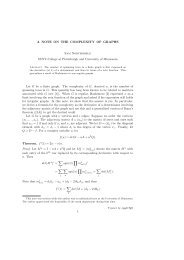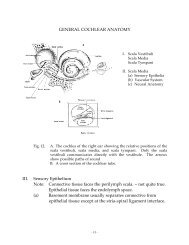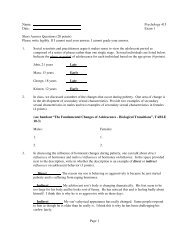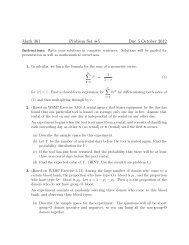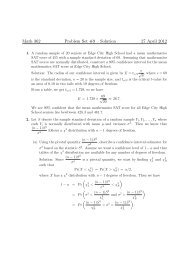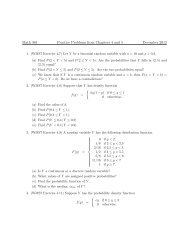Cognitive-Behavioral Body Image Therapy for Body Dysmorphic ...
Cognitive-Behavioral Body Image Therapy for Body Dysmorphic ...
Cognitive-Behavioral Body Image Therapy for Body Dysmorphic ...
Create successful ePaper yourself
Turn your PDF publications into a flip-book with our unique Google optimized e-Paper software.
BODY DYSMORPHIC DISORDER 265screened out persons with definite physical abnormalities but includedsubjects with distinctive features who nonetheless were within normallimits (e.g., a large but normally shaped nose). This is consistent withthe DSM and BDD literature. We also included mildly overweight butnot severely overweight subjects (a body mass index between 27.3 and32.3), reasoning that this degree of overweight is common enough (24%of American women according to the NHANESII study; Najjar & Rowland,1987) to consider these subjects normal-looking. Thus, some subjectscomplained of defects that were not completely imagined. However,none had true physical abnormalities and they all perceived theirappearance as being more anomalous and important than was realistic—thatis, they had overvalued ideas.Third, the types of appearance complaints in order of frequency, beginningwith the most frequent, were thighs (38%), abdomen (35%),breast size or shape (20%), skin blemishes (17%), buttocks (15%), facialfeatures (12%), overall weight (9%), scars (8%), aging (7%), hair(7%), height (6%), hips (5%), teeth (4%), and arms (3%). Thirty-eightpercent of subjects presented body weight or shape complaints only,44% presented both weight/shape and other complaints, and 17% presentednon-weight/shape complaints only. By comparison, fewer subjectsin the case series of Phillips et al. (1993) presented weight or shapecomplaints, although half of her cases were men and weight complaintsare less common in men. The significance of the type of appearancecomplaint in BDD is unknown. So far, we have not found any differencein body image and psychological symptoms between BDD patientswhen grouped according to type of appearance complaint, nor is anydifference reported in the BDD literature.Experimental Design and TreatmentSubjects signed a consent to participate prior to the initial evaluationand were randomly assigned to cognitive behavior therapy or no-treatmentcontrol. They were assessed again 2 weeks after the treatment versusno-treatment phase. Subjects in the no-treatment condition subsequentlywere offered therapy, limiting the experimentally controlledportion of the study from pre- to posttreatment. Treatment subjectswere assessed a third time at 4.5 months after treatment. Assessmentswere per<strong>for</strong>med by BA-level research assistants. Eligibility at the initialevaluation was checked by a clinical psychologist. Research assistantswere unin<strong>for</strong>med of the subjects' experimental condition at posttreatmentor follow-up evaluations.No-treatment control. These subjects were promised therapy after aminimum 10-week waiting period.<strong>Cognitive</strong>-behavior therapy. Treatment was provided in groups offour or five patients and one therapist and was scheduled as eight weekly2-hour sessions. If any member of the group was unable to attend asession, the session was canceled and rescheduled. Consequently, thegroups varied in the spacing of treatment sessions, which lasted from 8to 12 weeks. Therapists were the three authors: a clinical psychologistand two post-masters-level graduate students in clinical psychology.Subjects were charged <strong>for</strong> therapy at standard rates.<strong>Therapy</strong> was modeled after the cognitive behavioral body image therapyof Rosen etal. (1989,1990) but was modified to meet the needs of aBDD population (the treatment manual is available from the authors).Subjects were provided with an audiotape program on body image therapyby Thomas Cash (1991) that supported the cognitive-behavioralprinciples used in therapy sessions and structured the homeworkassignments.1. <strong>Therapy</strong> began with an explanation of our model of BDD causationand treatment. Subjects were helped to identify the developmentalantecedents of their body image problem, sociocultural and familialfactors, and the immediate sources of body image distress.2. Subjects explained concretely the distressing aspects of their appearanceto the other members of the group. As much as possible, theywere provided more objective feedback about the appearance of the perceiveddefect. For example, subjects with exaggerated complaints of excessivelylarge thighs or facial features estimated the size or shape of thedistressing part with drawings or moveable markers. These subjectiveperceptions were compared with actual size or shape using anthropometriccalipers or silhouettes drawn by other group members. Subjectsthen rehearsed more accurate representations of their appearancedefects.3. Subjects constructed a hierarchy of distressing aspects of theirappearance. Exposure therapy, thought stopping, and relaxation wereused to extinguish subjective distress at the sight of these features. Thiswas practiced first in therapy sessions when subjects stood in the groupand explained the hierarchy they had constructed while other membersstudied the relevant features of their appearance (subjects did not removetheir clothing). Subjects were taught to refrain from critical selftalkand to substitute more objective sensory descriptions of the bodyparts (e.g., "round nose" instead of "horse face"). Then at home, subjectsprogressed through the hierarchy by exposing themselves firstimaginally and then in front of the mirror, clothed and unclothed. Negativebody talk was to be interrupted with nonjudgmental sensory selfdescription.4. In support of the cognitive therapy, subjects kept a body imagediary throughout treatment in which they recorded relevant situations,the body image thoughts or beliefs they had in these situations, and theeffect of these on mood and behavior. Eventually, subjects were taughtto recognize maladaptive thoughts and to record disputing thoughts inthe diary. We encouraged subjects as much as possible to interrupt intrusivenegative self-statements about the aesthetics of their appearancesuch as, "Oh, my breasts are so limp and shapeless." Ultimately, thesethoughts are difficult to extinguish completely, some degree of body dissatisfactionis normal, and in many cases their self-statements were accurateto some extent. There<strong>for</strong>e, we focused mainly on helping subjectsto correct the more damaging beliefs related to the implications of physicalappearance <strong>for</strong> self-worth and relationships, especially those beliefsthat caused them to feel ashamed or embarrassed around other people.Typically subjects believed their looks proved they were unlovable, foolish,stupid, sluttish, immoral, disgusting, freakish, alien, and so <strong>for</strong>th.5. Exposure therapy was used to overcome distressing self-consciousnessand avoidance of feared body image situations. Exampleexposure assignments were wearing a <strong>for</strong>m-fitting outfit instead ofbaggy clothes, undressing in front of spouse, not hiding facial featureswith hands or combed-down hair, dressing to reveal scars, exercising inpublic wearing work-out clothes, drawing attention to appearance withmore trendy clothes, accentuating a distressing feature (e.g., lips) withmake-up or not wearing make-up at all, standing closer to people, andtrying on clothes or make-up in stores and then asking sales clerks <strong>for</strong>feedback on their looks. Exposure was carried out first in the therapysession, then prescribed as homework. The difficulty of assignments wasincreased by varying the exposure situations with respect to familiarityof people, physical proximity to others, and type of social interaction(e.g., giving a talk in front of a group vs. speaking individually to acolleague; speaking to a superior at work vs. speaking to a friend).6. Response prevention was used to decrease body checking behaviors.Examples are stopping weighing, inspecting in the mirror, or measuringbody size with measuring tapes or certain special clothes. Somesubjects were instructed to set a fixed time <strong>for</strong> dressing or to refrainfrom multiple changes of clothes. Some subjects were instructed to firstaccentuate their desire to check, by messing hair <strong>for</strong> instance, and thento refrain from self-inspection in the mirror. Repeatedly asking otherpeople <strong>for</strong> reassurance and comparing oneself with other people areother <strong>for</strong>ms of body checking that were targeted.7. Finally, subjects were instructed in the principles of relapse pre-



